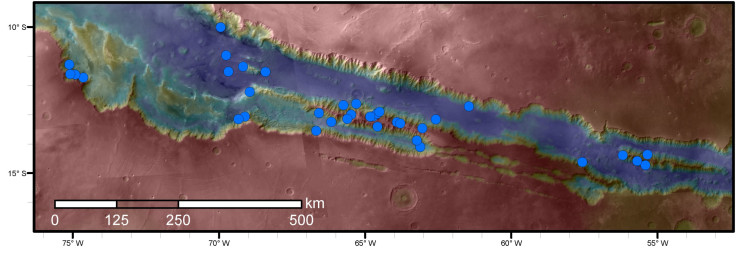Water On Mars: ‘Recurring Slope Lineae’ Puzzle Continues To Confound Scientists

Last year, NASA announced that it had discovered dark streaks known as “recurring slope lineae” on the surface of Mars, calling it the strongest evidence yet that liquid water still flows — or at least seeps — intermittently on the red planet. A new study, based on further analysis of data gathered by NASA’s Mars Reconnaissance Orbiter has muddled the picture, suggesting that in some cases, water pulled from the atmosphere by salts, or mechanisms with no flowing water, may explain the presence of the RSL.
The study examines thousands of these RSL — which seem to appear as dark lines extending downslope during a warm season and fade away during colder parts of the year — in 41 sites in the central and eastern portions of Valles Marineris region near Mars’ equator.
“There are so many of them, it's hard to keep track,” lead author Matthew Chojnacki from the University of Arizona’s Lunar and Planetary Laboratory, Tucson, said in the statement. “The occurrence of recurring slope lineae in these canyons is much more widespread than previously recognized. As far as we can tell, this is the densest population of them on the planet, so if they are indeed associated with contemporary aqueous activity, that makes this canyon system an even more interesting area than it is just from the spectacular geology alone.”

Data gathered so far indicates that there are two possible mechanisms through which RSL are formed — either extensive underground layers holding water release it during the warmer seasons, or some types of salts strongly pull water vapor out of the Martian atmosphere leading to the formation of a liquid brine on the ground.
However, both explanations are, at best, incomplete. Scientists believe it is highly unlikely that underground water can create the RSL in the canyon ridges and isolated peaks of Valles Marineris — where a lot of these streaks have been observed. On the other hand, if it is salts that are pulling water from the atmosphere, they would have to be extracting 10 to 40 Olympic-size swimming pools worth of water each year — something that is a near impossibility.
“There do seem to be more ways atmosphere and surface interact in the canyons than in blander topography, such as clouds trailing out of the canyons and low-lying haze in the canyons,” Chojnacki said. “Perhaps the atmosphere-surface interactions in this region are associated with the high abundance of recurring slope lineae. We can't rule that out, but a mechanism to make the connection is far from clear.”
© Copyright IBTimes 2024. All rights reserved.












